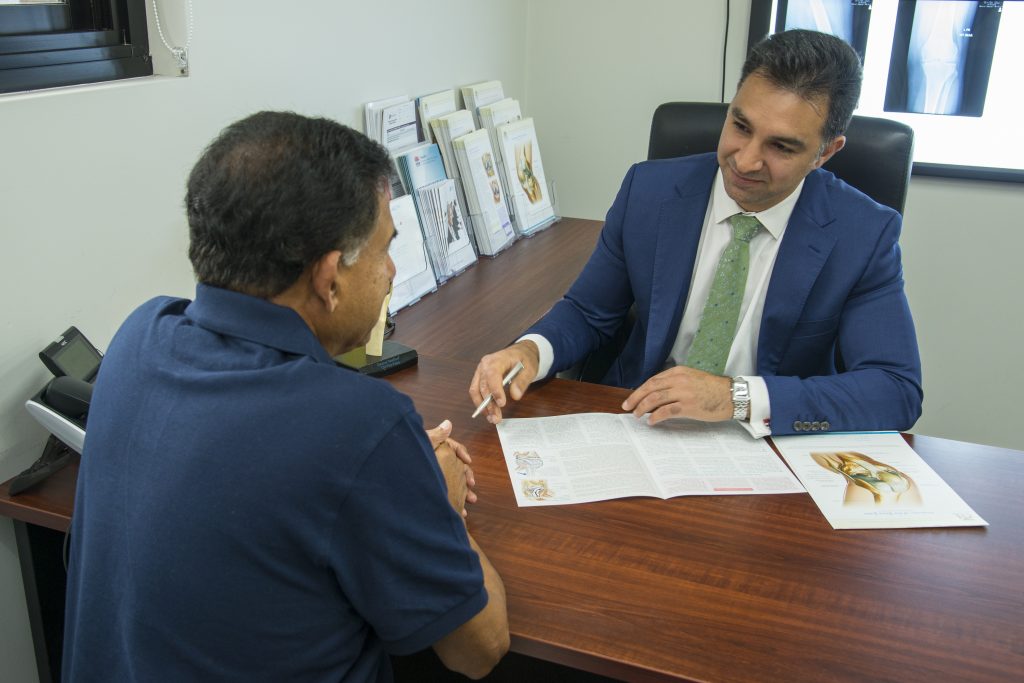Knee Replacement Surgery Treatments
The Knee Replacement Procedure
The goal of total knee replacement surgery is to relieve pain and restore the alignment and function of your knee.

The surgery is performed under spinal or general anaesthesia. Dr Khatib will make an incision in the skin over the affected knee to expose the knee joint. Then the damaged portions of the femur and tibia bones are cut at appropriate angles using specialized jigs. This removes the deformed parts of the bones and any bony growths and creates a smooth surface on which the implants can be attached.
Depending on the pathology and the clinical picture, the inner surface of the patella may be cut and resurfaced with a plastic (polyethylene) patella component. The femoral and tibial components are attached to the end of the femur and the tibia with or without bone cement. Dr Khatib will place a plastic piece called an articular surface between the implants to provide a smooth gliding surface for movement.
This plastic insert will support the body’s weight and allow the femur to move over the tibia. The femur and the tibia with the new components are then put together to form the new knee joint. With all the new components in place, the knee joint is tested through its range of motion. The entire joint is then irrigated and cleaned with a sterile solution. The incision is carefully closed, and a sterile dressing is placed over the incision.
Book an Appointment Today!
Post-operative care
Rehabilitation begins immediately following the surgery. A physical therapist will teach you specific exercises to strengthen your leg and restore knee movement. Ice is applied to the knee to decrease swelling. You will have an x-ray in recovery and once checked you will be able to walk with crutches or a walker. Your physical therapist will also provide you with a home exercise program to strengthen thigh and calf muscles. Antibiotics are given before and after-surgery to decrease the risk of infection. You will be given medication and calf pumps (calf-compressors) to decrease the chance of a clot (thromboembolism) in the legs or the lungs, but the best prevention is by getting the circulation moving and preventing stagnation of the blood through moving and performing certain exercises.
A blood transfusion is uncommon with modern anaesthetic and surgical techniques. Medication like Tranexamic acid (TxA) have reduced bleeding with joint replacement surgery and the need for blood transfusion afterward. Dr Khatib usually checks your haemoglobin levels after surgery and gives you iron and vitamin supplements so that your body can replace the blood lost during surgery.
Most patients are stable and ready to go home 3-5 days after surgery and continue with physiotherapy and rehabilitation as an outpatient or a physiotherapist may even attend to your house. Patients who live a split-level house, have many steps at home or who live alone may be more likely to need transfer to a rehabilitation facility for continued physiotherapy to get them to a safe level where they are ready for discharge home.

Risks and complications
As with any major surgery, possible risks and complications associated with total knee replacement surgery include:
- Knee stiffness.
- Infection.
- Blood clots (deep vein thrombosis).
- Skin numbness, nerve and blood vessel damage.
- Ligament injuries.
- Patella (kneecap) dislocation.
- Plastic liner wears out.
- Loosening of the implant.
If you find difficulty in performing simple activities such as walking or climbing stairs because of your severe arthritic knee pain, then total knee replacement may be an option for you. It is a safe and effective procedure to relieve pain, correct leg deformity, and help you resume your normal activities of daily living.
